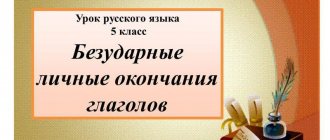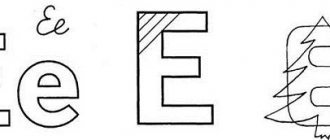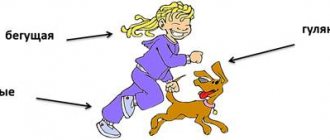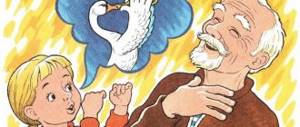Russian language lesson: Compound sentences. Generalization of what has been learned (grade 9)
Sinyagina Yu.V. Municipal educational institution secondary school No. 25, Orsk
Russian language lesson in 9th grade
Topic “Compound sentences. Generalization of what has been studied.”
Preparation for the State Examination
Developed by:
teacher of Russian language
Municipal educational institution secondary school No. 25, Orsk
Sinyagina Yulia Viktorovna
Lesson objectives:
Educational:
summarize and systematize material about complex sentences, develop the ability to find BSC in the text, distinguish between BSC and PP with homogeneous members
Developmental:
develop skills to argue and prove; develop skills in setting punctuation marks in the BSC in the text and in tasks like B7
Educating:
the formation of linguistic competence, the cultivation of conscious discipline and the cultivation of a love of literature.
Lesson type
: systematization and generalization of knowledge. Workshop lesson.
Teaching methods:
method of activating cognitive activity,
method of updating basic knowledge.
Pedagogical technologies:
computer, health-saving, developmental learning technologies (problem-based learning), personality-oriented, subject-oriented
Shapes:
class-lesson form of training, frontal-individual, written and oral surveys, individual, collective forms of work organization, training exercises, test tasks.
Students should know
: complex sentences of different types, groups of BSCs by meaning and conjunctions.
Students must be able to
: determine the semantic relationships between parts of the BSC, place punctuation marks in the BSC.
Means of education
: interactive whiteboard, multimedia projector, “Russian language” simulator, presentation “Compound sentence, B 7”, handouts, self-control sheet.
Differentiated approach:
individual work with low-performing and strong students
Basic concepts and terms of the lesson:
compound sentence, simple sentence with homogeneous members
“My friends, our union is wonderful!”
(A.S. Pushkin)
During the classes
- Introduction.
Good morning. Today I would like to start our lesson with the words of A.S. Pushkin “My friends, our union is wonderful!”
Remember the title of the poem from which these lines are taken and to whom they are dedicated. (“October 19.” Nikolai Korsakov, Fyodor Matyushkin, Ivan Pushchin, Alexander Gorchakov, Anton Delvig, Wilhelm Kuchelbecker)
These words have been spoken by more than one generation of people. They are carved on the granite pedestal of the monument to Pushkin the Lyceum student in the garden of Tsarskoye Selo. This address to friends conveys the confidence that people are capable of carrying brotherhood and spiritual kinship throughout their lives, despite any bitterness of fate.
I am pleased to consider you my friends, like-minded people who love their language and want to learn it, which I hope you will demonstrate in class today.
II. Announcement of the topic, setting the goal of the lesson.
Today we have a lesson on summarizing knowledge on the topic “Complex sentences.” What exactly are we going to do? Formulate the tasks that we will perform in class. So we will
Repeat
: information about a complex sentence; coordinating conjunctions;
Will learn:
distinguish complex sentences from other sentences, correctly place signs in the SSP and in the PP with homogeneous members connected by coordinating conjunctions.
Record in your notebooks the date and topic of the lesson “Compound sentences. Generalization of the material"
.
Today at the end of the lesson you will fill out a self-control sheet:
| What key concepts have been learned? | What caused the difficulties, what are the reasons for this? | Personal assessment of the quality of learning the material | Personal assessment of activity and contribution to the lesson | Suggestions on topic, lesson |
III.Checking homework during oral questioning
So, we will conduct a theory about the BSC during a frontal survey. We will refer to examples from homework throughout the survey. The students received an individual task: to write out examples of SSPs and simple sentences with homogeneous members from the works of A.S. Pushkin.
IV. A. Individual work
1. On computers - a spelling simulator (6 students)
2. Interactive whiteboard. “Bug fixes” (errors in the distribution of alliances)
It is necessary to correct errors on the board by correctly distributing conjunctions in the diagram.
B. Frontal survey
—
What kind of proposals do we call BSC? (examples from home work)
— Why does a simple sentence, complicated by homogeneous and isolated members of the sentence, introductory words and inserted constructions, still remain simple? (examples from home work)
— When is a dash put in the BSC?
— When is a semicolon used in the BSC?
— When is a comma used in BSC?
— And when is a comma not used in the BSC? —
Tell us the algorithm for setting punctuation marks in PP and BSC
— What meanings do various unions bring to the BSC?
Let's draw the main conclusion.
What is the role of coordinating conjunctions in the BSC?
Checking simulators and interactive whiteboards
V. Working with tests. Tell us the algorithm that needs to be followed when completing task B7 in the State Academy of Sciences
1. Algorithm:
2.Working with tests (orally) using slides – there are printed tests on the children’s desks
1. In 1810, Tsar Alexander I signed a project (1) drawn up by Minister Mikhail Speransky (2) on the creation of a special educational institution. The plans of the great statesman Speransky were directed to the future, (3) and he hoped for this closed institution. (3)
2. The grand opening of the Lyceum took place on October 19, 1811 in the presence of Alexander I (1), his family and the most notable people of the Russian state. After the ceremony, the boys were taken to lunch (2) and the guests toured the premises of the Lyceum. (2)
3. On one side of the table stood the lyceum students along with the director (1); on the other were the professors. The honored guests, headed by the emperor (2), were sitting in armchairs at the table, and the director of the Lyceum, V. Malinovsky, made a solemn speech in front of them. (2)
4. They were called “the first year of the Tsarskoye Selo Lyceum” (1) and they could consider themselves both schoolchildren (2) and students. (1)
VI. Eye exercise to the music of Johann Strauss “Tales of the Vienna Woods”
Teacher's word:
Many lyceum students, like A.S. Pushkin, recalled their years of study at the Lyceum and dedicated works to this time. And other generations turned to this topic, remembering the life of the genius of Russian literature A.S. Pushkin. Yes, many years have passed since then, but nothing has been forgotten, and today we will remember how it all began...
I invite you to get acquainted with the text, the author of which recalls the first arrival of the children, among whom was Pushkin, to the educational institution where they would live for six years. Basina Marianna Yakovlevna (1916 – 1994) – writer, literary critic.
Text on the screen, on the tables.
VI. Work with text
Write down the type of work: Working with text
- On a magnetic board, the student completes the task:
Parse the sentence
After evening tea everyone was taken to change clothes and the boys were transformed.
2.On the interactive board, the student completes an individual task:
Fill in the missing letters and explain your choice. Perform morphemic analysis of words with missing letters.
3.Expressive reading of the text by the teacher
(1) On the morning of October 9, 1811, a revival began near the director’s house. (2) The carriages drove up with a knock and teenage boys, accompanied by their relatives, gradually got out of them. (3) The children were sad and the adults were serious. (4) It was the future students of the Tsarskoye Selo Lyceum who began to arrive.
(5) The relatives left and the pupils remained with the inspector. (6) After evening tea, everyone was taken to change clothes and the boys dressed up. (7) The guys were dressed in double-breasted frock coats with shiny buttons, blue vests, long trousers and (half) boots. (8) The boys rushed to the mirror, looked at each other and spun around. (9) Some already imagined themselves as ministers, while others simply enjoyed their ceremonial appearance. (10) Everyone was happy. (M. Basina)
4. Independent work
Tasks:
1. Place punctuation marks and insert missing letters.
2.Indicate PPs with homogeneous members connected by a coordinating conjunction. Explain punctuation.
3. Indicate the BSC with a common minor member.
3. Find the BSC in the text and indicate their numbers.
5. Checking independent work
6. Checking individual assignments at the board
7.Working with an interactive whiteboard
Determine the meanings that various conjunctions bring to sentences.
The carriages drove up with a knock, and teenage boys, accompanied by their relatives, sedately got out of them.
The children's faces were sad, while the adults' faces were solemnly serious.
The relatives left, but the students stayed with the inspector
After evening tea everyone was taken to change clothes and the boys were transformed.
sequence value
sequence value
mapping value
meaning of opposition
VII. Homework assignment
Write down your homework
:
- Repeat topic «
SSP"
- Optional task
A) Write an essay - an argument on the topic: «
Why are commas needed in M. Basina’s text? » Don't forget to give examples. The volume of the essay is at least 90 words. B) Compose 7 tasks according to type B7
IX. Lesson summary
Our lesson is coming to an end. Let's find out together whether we were able to achieve the goals set at the beginning of the lesson:
We repeated:
information about a complex sentence; coordinating conjunctions;
We spent the whole lesson learning:
It is correct to put signs in the SSP and in the PP with homogeneous members connected by coordinating conjunctions.
We remembered
an important event in the life of A.S. Pushkin, whose work we get acquainted with in literature lessons.
X. Reflection. Filling out the self-control sheet:
| What key concepts have been learned? | What caused the difficulties, what are the reasons for this? | Personal assessment of the quality of learning the material | Personal assessment of activity and contribution to the lesson | Suggestions on topic, lesson |
Thank you for the lesson, which I want to end with the same words as at the beginning:
My friends, our union is wonderful!
After all, it gives us the opportunity to communicate, learn new things, improve, and create!
9




